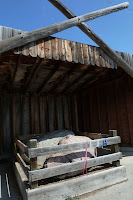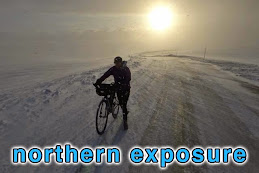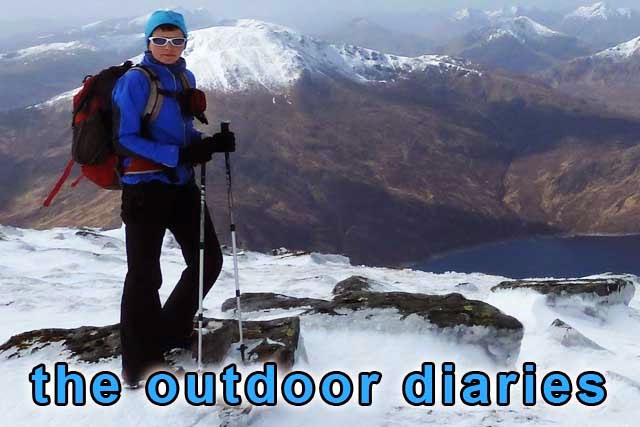Graham and I have now cycled across a big chunk of North Dakota. The gently furrowed high plains, once sculpted by glaciers and now covered with wheat, corn and canola, lend a simplicity to the landscape that is quite striking … but they conceal a sinister secret!
During the Cold War, when the West and the Russians amassed vast piles of nuclear weapons and pointed them at each other, the Americans built hundreds of nuclear missile launch sites in North Dakota, Montana and Wyoming – states that were within rocket range of Russia across the North Pole. When the Cold War ended and the Strategic Arms Reduction Treaty was signed in 1991, America shut down many of those missile sites.

On a balmy summer’s day when the fields were as green as billiard baize and puffy white clouds puttered across a blue sky, we came upon one of the old missile sites, November-33, near Cooperstown. On the surface there was not much to see except the circular blast door through which a nuclear missile would have exited at the start of its journey to death and destruction. We cycled a few miles further on to Oscar-Zero, a missile launch control facility, mothballed in 1991 but now open to the public. Our tour took us 50 feet below ground and through 3 feet thick blast doors to the missile control room. Inside were two control desks (one for each “missileer”, as the commanders in charge of missiles were called) with an array of instruments and switches. On the left of each desk was a loudspeaker through which the grave voice of a President might have instructed the missileers to initiate a launch sequence. Above was the little red box that contained the two keys required to turn the switch to “launch”. How chilling now to imagine that the turn of a key in this secret bunker on a quiet back road in North Dakota could have started a nuclear war and changed the face of the planet for eternity.
I returned to the surface and the outside world. With my back to Oscar-Zero, I looked out over the empty North Dakota landscape. I tried to imagine what it would have been like for a missileer to step out here some weeks after launching the missiles that started World War III and to gaze out into a nuclear winter. The land was empty to the horizon … there was no bustle of people … no sign of life … and all that could be heard was the eerie whistle of the wind through the wire fence.
For the people of North Dakota today a more real threat comes in the form of nature’s weapons of mass destruction – wind and water! Every day as we cycle across the open plains we keep an eye open for “funny lookin” clouds that may signal the beginnings of a tornado. People have told us stories of tornadoes that can demolish a house but a few yards away leave a flowerpot standing. We met two cyclists who had to take cover in a roadside ditch when caught out in the open in the path of a tornado.

But most devastating of all is the extensive flooding we have seen in North Dakota caused by the thaw of a record snow pack last winter followed by a very wet spring. Since we set out cycling west from Boston we have seen pictures flashed across TV screens of a small town in North Dakota demolished by floodwater and a few days ago we found ourselves cycling through the aftermath. That town was Minot. We cycled along deserted streets where all that stood were empty shells of houses gutted by water and the debris and mud that washed through with it. On the sidewalks were huge piles of garbage as people began the process of demolishing what couldn’t be saved. It was very sad – all those homes and the hopes and dreams of the families that lived in them, swept away in a moment.
It was a surreal day as within a mile I cycled out of the flooded zone and into the unaffected commercial centre – from a disaster zone to Starbucks in 10 minutes. I treated myself to two coffees – it’s the last Starbucks until Seattle!
That night a storm passed over Minot sending down more rain and wind but we were safely tucked up. In Starbucks I’d met Karla who invited us to stay out at her farm a few miles west of town. It was one of the loveliest places I have stayed on this trip. The farmhouse is built on a plateau at the end of a long avenue of evergreens and looks out over rounded hills separated by wooded coulees where moose, elk and wild turkey roam. Humming birds and dragonflies make Karla’s garden their home. In the evening we sat on the porch with coffee as the sun sank and the breeze played music on the wind chimes. Before cycling away next day, we were joined by Karla’s friends and neighbours for a traditional American breakfast of pancakes with maple syrup, eggs, sausages, fresh berries and good, strong coffee!
Nature may be adept at mass destruction but she’s also quite handy at mass construction. In a few days we’ll cycle out of North Dakota and into Montana where one of nature’s mass constructions will be on our distant horizon – the Rocky Mountains!
More photos on Flickr and we’ve been on the telly again – click the “Sleepless til Seattle” link and then the “video archive” link.












